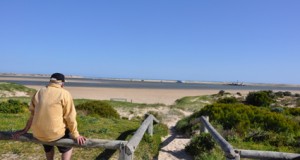more water – a lifeline to the river

The mouth of the river Murray
Water is the current which carries conversation in the river port of Goolwa. And right now, everyone in this strategically positioned town where the River Murray meets the sea is elated that for the first time for many years water has flowed over the Goolwa Barrage. There was a joyful mood at the recent opening of the River Life photographic exhibition at the yacht club when the MC commented how exciting it had been to see the river levels rise daily after all those years of watching it ebb away. At the opening of the Goolwa Regatta Yacht Club’s season, the governor of South Australia, Rear Admiral Kevin Scarce commented how great it was to see yachts sitting in the water in the natural course of the river. “This time last year, you could have played cricket out there,’’ he said pointing to the lineup of yachts bobbing in the water.’’
This community has watched helpless as the “bottom end of the Murray has dried up’’ over the past decade. Aware Australians know that our major river system is in crisis through the combined impact of over allocation of water upstream and years of drought. One good snow season and one winter of flooding rain in eastern states is not going to change the slow demise of the river, the experts say and I believe them.
This fact has been hammered home these last few days with the release of the long-awaited Murray Darling Basin Authority’s draft plan. It signals drastic cuts of water entitlements ranging from 27-37 per cent in order to return healthy environmental flows through the Lower Lakes and the River Murray mouth. The mouth of the River Murray almost closed up in 2002 – which would have been an environmental disaster – and dredging has kept it open since.
The Murray Mouth is within cooee of Hindmarsh Island, where we now live and today we drive to survey the problem, a mere 11 kilometres away across the island. We drive literally to the end of the road on the island and there we can see with our own eyes the issue to be addressed this week with the release of the Murray Darling Basin Authority’s Draft Plan. Right here there is a sliver of water which runs into the sea at the end of the sandbar opposite us and this is the mouth of the mighty Murray – reduced to a mere trickle in relation to the massive river system behind it.
This is the Mouth of the major river system of our continent, which is in decline. We stand here with about seven people – all strangers to Olivier and I, but we share an unspoken horror as we read the billboard outlining the need for dredging. The machinery drones in our ears – its large apparatus gathering 600,000 cubic metres of sand annually and depositing it on the sandhills either side of the mouth to keep it open. At this pivotal point in our history so much is at stake where we have a dying river system, which is vital to the health of the Lower Lakes, Alexandrina and Albert and the Coorong, a unique ecosystem of fresh water and sea water, which runs in a channel behind the sandhills, parallel to the ocean. The whole ecosystem is the habitat of water birds and fish which is now seriously under threat.
The Lakes, River and Coorong Action Group chairwoman, Di Bell, of Finniss River reckons in The Advertiser that the key to restoring the health of the River Murray is for water to flow through the mouth at Goolwa. She also believes over-allocation is the cause of the crisis. Mayor of Alexandrina, Kym McHugh agrees – a regular flow through the Murray mouth is essential for a “sustainable river system’’.
He calls for the “right balance’’ between environmental and agricultural interests.
Fixing the Murray-Darling basin may cost “many billions of dollars more than predicted’’ (front page The Australian Friday October 8). It recommends cutting the water allocation of irrigators upstream by between 27-37 per cent to return 3000-4000 gigalitres of water to the river. This has triggered warnings that about 20,000 jobs will be lost, not forgetting the economic impact on whole rural communities. However, we all, as a broader community jmust bite the bullet. This is no time for ducking and weaving or buck-passing by politicians. Nor do we, as a people, need a bunfight between irrigators, farmers and conservationists. This is a problem which we all must take to heart and seek a fair solution which will restore the health of the river, its viability and resilience in years of drought and most important, protect the environment, the habitat of our precious water birds, fish and wildlife.
It is alarming to learn from the Australian Conservation Foundation that 20 of the 23 river basins in the Murray-Darling system were in a “poor or very poor’’ condition. Put simply, far too much water has been taken from the river for it to survive drought.
Meanwhile, the Goolwa community waits for the lobbying to begin following the release of the draft plan guidelines for the river system, which is the most important document in the history of the River Murray since European settlement. All parties with a vested interest need to give a lot because the consequences of a dying river system with a closed mouth is untenable. I now live at the very bottom end of the Murray-Darling river system and our local community have the most to lose if this one last chance fails to restore a sustainable river environment. No wonder water is the word on everyone’s lips here.
RSS feed for comments on this post. TrackBack URI



